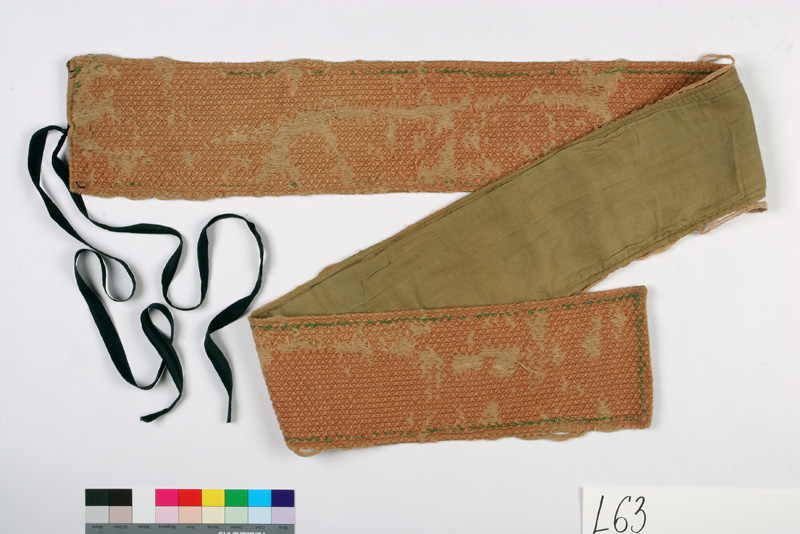6030 Vlasim
| Binder |
| BINDER11 |
| Description |
| Orange knit with green stitched border; one sided on linen back; two black ribbons at one end |
| Binder Type |
| Binder |
| Fabric Type |
| Wool |
The Binders
The Torah klaf (parchment) is attached to two poles (in Hebrew Etz Chayim) and in order to hold them together when rolled up a binder (often called a wimple) is used.

Embroidered lettering
In the past these binders were traditionally made from the linen or cotton cloth that had been used to cover new-born males during the circumcision ceremony (brit milah). This would be laundered and cut into four strips which would then be joined to make one long piece.
The bonders were often embroidered using silk thread, giving the boy’s Hebrew name and date of birth according to the Jewish calendar. Occasionally illustrations of a Torah scroll, and Chuppah (marriage canopy) were also added

Embroidered animal motif
Embroidery

A Binder with detail of an embroidered Chuppah and an embroidered Torah Scroll

Embroidery letters in gold thread on a green velvet cloth

Simple binder
The 400 Binders
The Museum houses more than 400 binders, one of the largest collections in the world. Predominantly from the 19th century, however some are older and a few are newer.
The Binders are of three basic types. The first being the traditional wimpel made from the cloth used at a boy’s circumcision. These came predominantly from Ashkenaz, the lands of German-speaking Jews; Southern Germany, Alsace, Switzerland, Bohemia and Moravia. There are many other names and spellings for this type of binder, such as mappa, mappe, mappah, wrapper, thorahwickelband etc. These names depended upon the customs of the various communities.
The second type is a “short” binder, made to wrap once around the Torah Scroll and fasten quickly with a hook, a button or a tie. Once again, the various styles and techniques employed reflect the local and prevalent folk art of Bohemia and Moravia.
The third example has no obvious Jewish connection apart from its usage, but is derived from a miscellaneous selection of whatever material was available.
There are a number of binders in the collection that have obviously been prepared for embroidery but are blank. Sadly, it would seem either that the baby was still-born or, in an age of poverty and high infant mortality, that he died before the embroidery could be done



